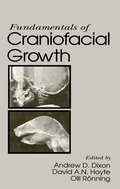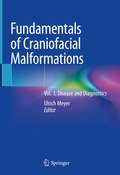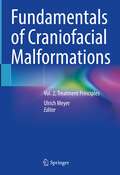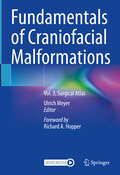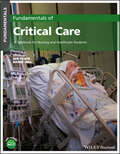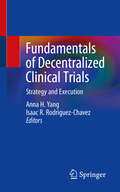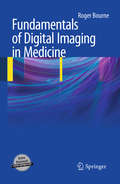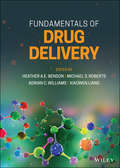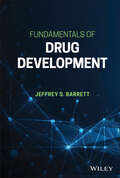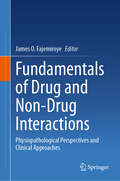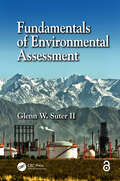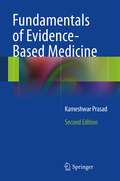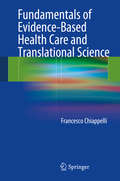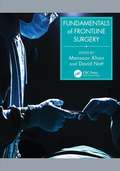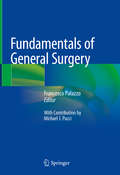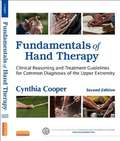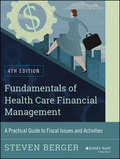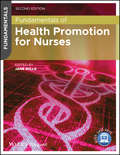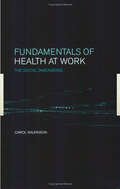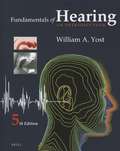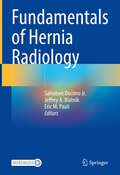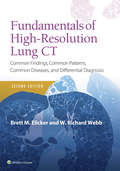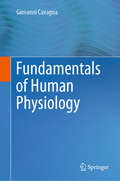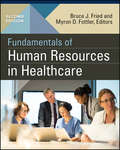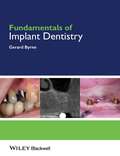- Table View
- List View
Fundamentals of Craniofacial Growth
by Andrew D. Dixon David A.N. Hoyte Olli RonningThis book brings together in one volume selected important topics in craniofacial growth. Topics include: principles of skeletal growth; osteogenesis and its control; formation of the cranial base and craniofacial joints; prenatal development of the facial skeleton; growth of the mandible, nasomaxillary complex, orbit, cranial base, ear capsule, and cranial vault; bone remodeling; muscles; soft tissues; and blood vessels.Fundamentals of Craniofacial Growth contains detailed illustrations and extensive reference lists. Independently authored chapters provide comprehensive reviews encompassing both contemporary and historical perspectives. In addition to medicine and dentistry, contributors provide expertise from such diverse backgrounds as anatomy, biology, biomathematics, embryology, orthodontics, physical anthropology, and plastic and reconstructive surgery.
Fundamentals of Craniofacial Malformations: Vol. 1, Disease and Diagnostics
by Ulrich MeyerThis is the first volume in an interdisciplinary three-book series covering the full range of biological, clinical, and surgical aspects in the evaluation, diagnosis, and treatment of patients with craniofacial malformations. This volume opens by considering general topics such as developmental biology and disease classification and then examines in depth the biological basis of the various malformations, including craniosynostoses, cleft-lip and palate with complex orofacial clefts, branchio-oculo-facial syndromes, rare syndromes, soft tissue malformations, and dysgnathia. Psychological aspects, including psychological evaluation methods and therapies and quality of life issues, are then addressed. Finally, all relevant clinical, radiological, and genetic investigations are described and important diagnostic issues are explored. Featuring numerous high-quality illustrations, the book will be of high value for all clinicians, researchers, and postgraduate students who deal with these malformations. The accompanying two volumes describe treatment principles and present in an atlas manner all relevant surgical techniques in detail. The content of this multivolume set, written by the world’s leading research and clinical specialists in their discipline, represents therefore the recent intellect, experience, and state of this medical field.
Fundamentals of Craniofacial Malformations: Vol. 2, Treatment Principles
by Ulrich MeyerThis is the second volume in an interdisciplinary three-book series covering the full range of biological, clinical, and surgical aspects in the evaluation, diagnosis, and treatment of patients with craniofacial malformations. In this volume, readers will find detailed discussion of the treatment principles for craniosynostoses, orofacial clefts, branchio-oculo-facial syndromes, soft tissue malformations, dysgnathia and rare syndromes. In addition to description of important facets of treatment and the treatment planning process, guidance is offered on diagnosis and disease classification. Featuring numerous high-quality illustrations, the book will be of value for all clinicians and trainees who are involved in the management of patients with these malformations. The accompanying two volumes discuss the biological basis of disease, psychological aspects, and diagnostic issues and present surgical techniques with the aid of accompanying surgical videos.
Fundamentals of Craniofacial Malformations: Vol. 3, Surgical Atlas
by Ulrich MeyerThis is the final volume in an interdisciplinary three-book series covering the full range of biological, clinical, and surgical aspects in the evaluation, diagnosis, and treatment of patients with craniofacial malformations. In this volume, all key operations from early infancy to adulthood employed in the treatment of different malformations – craniosynostoses, orofacial-clefts, branchio-oculo-facial syndromes, dysgnathia, rare syndromes, soft tissue malformations – are described in detail. All operations are depicted in a step by step manner through of a wealth of high-quality intraoperative photos and related illustrations. In addition, operations are discussed in light of the recent state of various other surgical techniques. The volume will meet the needs of all surgeons and surgical trainees who deal with these malformations. The remaining two volumes focus on the biological basis of disease, psychological aspects, and diagnostic issues and on treatment principles.
Fundamentals of Critical Care: A Textbook for Nursing and Healthcare Students (Fundamentals)
by Ian Peate Barry HillFundamentals of Critical Care Fundamentals of Critical Care A Textbook for Nursing and Healthcare Students In Fundamentals of Critical Care, a team of clinicians and health educators deliver an accessible, timely, and evidence-based introduction to the role of nurses and healthcare practitioners in critical care. The book explores fundamental concepts in critical care and their implications for practice. Each chapter outlines essential knowledge necessary to understand key concepts and includes high quality, full-colour artwork to enhance learning and recall. Readers are also provided with clinical scenarios, practice questions, and red and orange flags to indicate physiological and psychological alerts respectively. Covering a range of common and specialised disease processes and treatments requiring critical care, the book provides: A thorough introduction to the critical care unit, including philosophies of care, ways of working, humanisation, and outreach Comprehensive exploration of organisational influences, including political, local, national, and international influences Practical discussion of legal, ethical, and professional issues, as well as evidence-based approaches to critical care In-depth examination of nursing care assessment tools, nursing communication, cognition, pharmacology, and more Perfect for nursing students and trainee nursing associates, Fundamentals of Critical Care: A Textbook for Nursing and Healthcare Students will also earn a place in the libraries of healthcare students in physiotherapy, paramedicine, medicine, and those returning to practice. All content reviewed by students for students. If you would like to be one of our student reviewers, go to www.reviewnursingbooks.com to find out more. To receive automatic updates on Wiley books and journals, join our email list. Sign up today at www.wiley.com/email
Fundamentals of Decentralized Clinical Trials: Strategy and Execution
by Anna H. Yang Isaac R. Rodriguez-ChavezA timely and first-of-its-kind publication in the field, this short handbook on decentralized clinical trials (DCTs) offers a thorough exploration of the potential of DCTs to revolutionize clinical research through innovative approaches, including technology. This concise and easy-to-read publication is especially designed for those who seek to understand and get up-to-speed on what DCTs mean and how to work in this rapidly evolving field. As discussed in Chapter 1, DCTs address barriers to traditional trial participation, promoting accessibility, diversity, equity, and participant engagement. Chapter 2 examines how the COVID-19 pandemic and evolving regulations accelerated the adoption of DCTs, building on their application since the early 2000s. Chapters 3 and 4 highlight remaining operational complexities and the importance of careful trial design to ensure scientific rigor, operational feasibility, and compliance with regulations, ethics, data privacy, and participant safety. The book emphasizes the significance of the FDA's draft guidance on DCTs, detailing investigator responsibilities, local health care providers' use, and essential sponsor considerations. Chapter 5 stresses the need for clear metrics to evaluate DCT adoption's impact on recruitment, retention, diversity, safety, and cost efficiencies. Overall, this guide tracks DCT advancements and encourages readers to contribute to evidence-based integration, meeting participant expectations for convenience and fostering faster, more inclusive clinical studies. Ultimately, this book aims to support the transformation of modern clinical research, developing medical products more efficiently for those in need. A major contribution to the literature on clinical research, this work will be a resourceful tool to anyone interested in embracing decentralized clinical research and improving access and participation for all.
Fundamentals of Digital Imaging in Medicine
by Roger BourneIn general, image processing texts are intended for students of engineering and computer science, and there is little written at all on the specific requirements of medical image processing. Students of medical radiation science (Diagnostic radiography, Nuclear medicine, Radiation therapy) usually have minimal mathematical and computer science training and find the available texts incomprehensible. A text that explains the principles of image processing in minimally-mathematical language is needed for these students. Contrary to the claims of some textbook authors, the vast majority of technologists that process images do not need to understand the mathematics involved, but would nevertheless benefit from a thorough understanding of the general process.
Fundamentals of Drug Delivery
by Heather A E BensonA comprehensive guide to the current research, major challenges, and future prospects of controlled drug delivery systems Controlled drug delivery has the potential to significantly improve therapeutic outcomes, increase clinical benefits, and enhance the safety of drugs in a wide range of diseases and health conditions. Fundamentals of Drug Delivery provides comprehensive and up-to-date coverage of the essential principles and processes of modern controlled drug delivery systems. Featuring contributions by respected researchers, clinicians, and pharmaceutical industry professionals, this edited volume reviews the latest research in the field and addresses the many issues central to the development of effective, controlled drug delivery. Divided in three parts, the book begins by introducing the concept of drug delivery and discussing both challenges and opportunities within the rapidly evolving field. The second section presents an in-depth critique of the common administration routes for controlled drug delivery, including delivery through skin, the lungs, and via ocular, nasal, and otic routes. The concluding section summarizes the current state of the field and examines specific issues in drug delivery and advanced delivery technologies, such as the use of nanotechnology in dermal drug delivery and advanced drug delivery systems for biologics. This authoritative resource: Covers each main stage of the drug development process, including selecting pharmaceutical candidates and evaluating their physicochemical characteristics Describes the role and application of mathematical modelling and the influence of drug transporters in pharmacokinetics and drug disposition Details the physiology and barriers to drug delivery for each administration route Presents a historical perspective and a look into the possible future of advanced drug delivery systems Explores nanotechnology and cell-mediated drug delivery, including applications for targeted delivery and toxicological and safety issues Includes comprehensive references and links to the primary literature Edited by a team of of internationally-recognized experts, Fundamentals of Drug Delivery is essential reading for researchers, industrial scientists, and advanced students in all areas of drug delivery including pharmaceutics, pharmaceutical sciences, biomedical engineering, polymer and materials science, and chemical and biochemical engineering.
Fundamentals of Drug Development
by Jeffrey S. BarrettFundamentals of DRUG DEVELOPMENT Enables readers to understand the process of pharmaceutical research, its regulatory basis, and how it fits into the global healthcare environment This book discusses how to conduct pharmaceutical research and the context for how the industry fits into global healthcare. Holistically, the well-qualified author helps readers and students of drug development appreciate the time and expense of the process. Specifically, the work identifies the emerging trends shaping the future of drug development, along with important related topics like generic drugs, data sharing, and collaboration. To aid in seamless reader comprehension, the book includes a glossary of terms and a self-assessment quiz for each chapter at the end. PowerPoint slides are also available as an online ancillary for adopting professors. Sample topics covered in the book include: Drug development and its phases Decision-making processes, drug development milestones, and compound progression metrics The various disciplines involved along with an assessment of the complexity and risks associated across the stages of development Differences in the nature and scope of development programs due to the therapeutic area of interest Associated costs and resources required Graduate students and professors teaching courses in drug development, drug discovery, pharmaceuticals, medicinal chemistry, and drug synthesis will be able to use this book as a complete resource for understanding all the complexities and nuances involved in the drug development process.
Fundamentals of Drug and Non-Drug Interactions: Physiopathological Perspectives and Clinical Approaches
by James O. FajemiroyeThis book covers nutrients, active principles from phytotherapy/herbal products, and drug classes while identifying potential interactions. Didactic approaches to drug and non-drug interactions and cutting-edge reports are included in each chapter that promotes safer drug prescription and use. The physiopathological overview in this book provides background for chemistry, pharmacology, and mechanistic bases of drug and non-drug interaction as well as clinical cases and predictive screenings. This book is intended for undergraduate students studying medicine, nursing, nutrition, biomedicine, and pharmacy.
Fundamentals of Environmental Assessment
by Glenn W. Suter IIBased on the "go to" book in the field of ecological risk assessment, this shorter, principles-based, updated textbook is essential for students and new practitioners who want to understand the purposes of environmental assessments and how to achieve them. It includes environmental risks to humans as well as nonhuman populations and ecosystems, and most types of environmental assessments. Drawing upon the author’s extensive experience in the field, first as a senior research staff member in the Environmental Sciences Division at Oak Ridge Laboratory and then as science advisor in the United States Environmental Protection Agency’s National Center for Environmental Assessment, the book explains fundamental principles and basic techniques and illustrates them with example applications which carry through multiple chapters and make this book a practical and hands-on guide. Both the content and the style are inviting and approachable to different levels of students.Features Integrates human health and ecological assessments. Includes epidemiological, risk, causal, impact, and outcome assessments. Focuses on fundamental principles that are applicable in all nations and legal contexts. Employs an engaging style and draws on the author’s practical experience. Explains fundamental concepts in short chapters, making it perfect for beginners in the field. Explains the challenges and rewards of a career in environmental assessment. This book is a practical guide for senior and graduate students in environmental sciences and management, as well as new practitioners of assessment who want to understand the purposes of environmental assessments and how to achieve them. The Open Access version of this book, available at www.taylorfrancis.com, has been made available under a Creative Commons Attribution-Non Commercial-No Derivatives (CC-BY-NC-ND) 4.0 license.
Fundamentals of Evidence Based Medicine
by Kameshwar PrasadThis is a basic book on evidence-based medicine (EBM). It starts with an introduction to the topic. It outlines the relationship between EBM and research and quality of care. Then It goes on to cover the most commonly used modules of EBM, i.e. therapy, diagnosis, prognosis and meta-analysis. Each module starts with an introduction to fundamental concepts, and description of the related research process, and then follows the critical appraisal of related type of research artcle. At the end, it covers the different systems of grading of level of evidence and strength of recommendations. The book also has three examples of critical appraisal on diagnosis, therapy, and meta-analysis.
Fundamentals of Evidence-Based Health Care and Translational Science
by Francesco ChiappelliComparative effectiveness research - the conduct and synthesis of systematic research in order to compare the benefits and harms of alternative treatment options - is of critical importance in enabling informed health care decisions to be made. This user-friendly, practical handbook examines in depth how best to perform such comparative effectiveness research. A wide range of topics and methods are discussed, including research synthesis, sampling analysis, assessment of evidence design, systematic evaluation of statistical analysis, and meta-analysis. The discussion extends well beyond the fundamentals by encompassing "complex" systematic reviews, "cumulative" meta-analyses, and logic-based versus utility-based decision making. Health care providers, researchers, instructors, and students will all find this to be an invaluable reference on the compelling current issues and important analytical tools in comparative effectiveness research.
Fundamentals of Frontline Surgery
by Mansoor KhanFundamentals of Frontline Surgery is an easy to read text, written by world class faculty, that provides clinicians with succinct and didactic information about what to do in high intensity, resource limited situations.With global conflicts and humanitarian emergencies on the rise, there has been a dramatic uptake in the number of volunteers for both military and humanitarian operations. This manual aids best practice and fast decision making in the field.
Fundamentals of General Surgery
by Francesco Palazzo Michael J PucciThis book provides a comprehensive guide to the surgical skills required during general surgery. General Concepts are covered with descriptions of basic terminology, the logic behind specific approaches, limitations of specific skills, technical and practical considerations, and safety of using specific approaches and skills. More advanced topics including gastro-intestinal anastomosis, exploring a patient after a major trauma, and managing crisis situations are also discussed, as well as current controversies and future directions within general surgery.Fundamentals of General Surgery is relevant to trainees in general surgery and its subspecialties, and aims to give them an easy to access resource that contains real life examples, iconography, and recommended further reading.
Fundamentals of Hand Therapy: Clinical Reasoning and Treatment Guidelines for Common Diagnoses of the Upper Extremity (2nd Edition)
by Cynthia CooperPerfect for hand therapy specialists, hand therapy students, and any other professional who encounters clients with upper extremity issues, Fundamentals of Hand Therapy, 2nd Edition contains everything you need to make sound therapy decisions. Coverage includes hand anatomy, the evaluation process, and diagnosis-specific information. Expert tips, treatment guidelines, and case studies round out this comprehensive text designed to help you think critically about each client’s individual needs. <p><p> "Overall, a very clear readable style is adopted throughout, with theory supported by various anecdotal case studies. Excellent use is made of illustrations, and many chapters contain the helpful addition of ‘clinical pearls’ or ‘tips from the field’, which are an attempt to make transparent the links between theory and practice. In conclusion, this is an excellent core text for reference purposes." Reviewed by: British Journal of Occupational Therapy Date: Aug 2014 <p> Clinical Pearls and Precautions highlight relevant information learned by the experienced author and contributors that you can apply to clinical practice.<br> Case examples included in the diagnoses chapters in Part Three demonstrate the use of clinical reasoning and a humanistic approach in treating the client.<br> Diagnosis-specific information in the final section of the book is well-organized to give you quick access to the information you need.<br> Special features sections such as Questions to Discuss with the Physician, What to Say to Clients, Tips from the Field, and more help readers find their own clinical voices.<br> Online sample exercises give you a pool to pull from during professional practice.<br> NEW! Chapters on yoga and pilates provide guidance into new ways to treat upper extremity problems.<br> NEW! Chapter on wound care gives you a thorough foundation on how wounds impact therapeutic outcomes.<br> NEW! Chapter on orthotics has been added to cover basic splinting patterns.<br> NEW! Online resources help assess your understanding and retention of the material
Fundamentals of Health Care Financial Management
by Steven BergerIn this thoroughly revised and updated third edition of Fundamentals of Health Care Financial Management, consultant and educator Steven Berger offers a practical step-by-step approach to understanding the fundamental theories and relationships guiding financial decisions in health care organization. Set in a fictional mid-sized hospital, the book is written in diary form, taking the reader into the inner workings of the finance executive's office. This introduction to the most-used tools and techniques of health care financial management includes health care accounting and financial statements; managing cash, billings and collections; making major capital investments; determining cost and using cost information in decision-making; budgeting and performance measurement; and pricing. As in the previous editions, this book introduces key practical concepts in fundamental areas of financial management.
Fundamentals of Health Promotion for Nurses (Fundamentals)
by Jane WillsFundamentals of Health Promotion for Nurses is a concise, accessible introduction to health promotion and public health for pre-registration nursing students and newly qualified nurses. Promoting the health and wellbeing of patients is a vital part of the nursing role, and the updated second edition of this user-friendly book discusses the foundations for health promotion practice using practical examples, activities and discussion points to encourage readers to reflect on their values, debate the issues and apply their knowledge and understanding to practice.
Fundamentals of Health at Work
by C. WilkinsonFundamentals of Health at Work is an engaging re-assessment of workplace health, with particular emphasis on the neglected issues of the social context of the working environment and the impact on individuals of their workplaces. In looking at the historical context of the subject and at the concepts of health and illness, a selective series of tho
Fundamentals of Hearing: Fifth Edition
by William YostAn introductory text on hearing sciences, this book includes auditory, anatomy, physiology, psychoacoustics, and perception content. Illustrated with over 200 figures, it contains a complete Glossary of terms from the American Standards Institute, a combined subject/author index, and a comprehensive bibliography.
Fundamentals of Hernia Radiology
by Jeffrey A. Blatnik Eric M. Pauli Salvatore Docimo Jr.This book offers a complete focus on the radiographic analysis of the abdominal wall and hernias. An estimated 20 million hernias are repaired annually throughout the world. As the technology utilized to complete hernia repairs becomes more complex, surgeons are required to have a more thorough understanding of the radiographic anatomy and diagnostic modalities used to evaluate hernias. Furthermore, the amount that now goes into the preoperative planning of hernias for complex repairs (such robotic and open transversus abdominis muscle release procedures) requires an understanding of radiology and the ability to identify nuances of anatomy offered by the imaging. The use of mesh and extent of re-do hernia repairs has also complicated radiographic evaluation of hernias. The text is a comprehensive review of abdominal wall imaging broken down into individual types of hernia. Each hernia type is discussed with consideration to the best type of imaging evaluation, unique radiographic findings and considerations prior to repair. Representative images, diagrams and videos are used to point out anatomy and features of the hernia. This text offers the first-of-its-kind standardized approach to evaluating hernias radiographically. Most importantly, each hernia and chapter is approached with the surgeon in mind, meaning, authors explain the radiology based on anatomy and with a plan for surgical repair on the horizon. Select chapters include illuminating videos to give context to the text. This is an ideal guide for practicing surgeons and trainees treating patients with hernias.
Fundamentals of High-Resolution Lung CT: Common Findings, Common Patterns, Common Diseases and Differential Diagnosis
by Brett M. Elicker W. Richard WebbPublisher's Note: Products purchased from 3rd Party sellers are not guaranteed by the Publisher for quality, authenticity, or access to any online entitlements included with the product. In clear and concise language, Fundamentals of High-Resolution Lung CT, provides a straightforward guide to understanding the high-resolution lung CT (HRCT) assessment of diffuse lung diseases. You will learn to accurately interpret HRCT findings, and how those findings can translate into the correct diagnosis or appropriate differential diagnosis. This volume includes over 600 images we consider classic, many of which have been updated and improved to facilitate easier reading and more precise interpretation.
Fundamentals of Human Physiology
by Giovanni CavagnaThis textbook explores the fundamental qualitative and quantitative aspects of human physiology. It approaches biological and physiological processes and phenomena from a quantitative perspective, revealing how physiological problems can be mathematically formulated starting from simple laws of physics. The book addresses a broad range of topics, including: the statics and dynamics of circulation; muscle and sarcomere force-length and force-velocity relations, together with their mechanisms and functional consequences; subdivisions and meaning of the heat produced by muscle; locomotion, statics and dynamics of respiration; diffusion of gases and acid base equilibrium; phonation; general functions of the kidney and of the different sections of the nephron; changes in clearance with a substance’s plasmatic concentration; pH regulation and the kidney; Donnan’s equilibrium and its consequences; and the Nernst equation. The book offers the ideal learning resource for students of human physiology courses in medicine and biomedicine, as well as biomedical engineering and biophysics graduate students. An elementary grasp of mathematics and physics is sufficient to understand the content.
Fundamentals of Human Resources in Healthcare, Second Edition (Gateway to Healthcare Management)
by Bruce FriedInstructor Resources: Test Bank, Instructor’s ManualHuman resources are the bedrock of healthcare organizations. Yet healthcare faces severe staffing shortages, both as a result of the aging population and workforce and because of wide disparities in the geographic distribution of workers. To attract and retain this increasingly scarce resource—and to inspire the best from their employees—healthcare managers must know how to develop, nurture, and coach their staff for success. Fundamentals of Human Resources in Healthcare takes a back-to-basics approach to workforce management. It sets forth fundamental concepts that will help healthcare managers succeed at the most important and challenging part of their job: managing people. Unlike books that peddle the latest oversimplified solution or quick-fix cure-all for workforce challenges, this book presents proven best practices and evidence-based strategies for successfully working with employees. This new edition puts human resources in the context of today’s healthcare environment, with all of its rapid, ongoing, and unprecedented changes. Thoroughly revised and updated, it includes:• A new chapter on enhancing diversity and inclusion in healthcare organizations• Expanded material on physician compensation, including changes in incentives; compensation practices in patient-centered medical homes and accountable care organizations; and challenges in measuring physician productivity• Revised and updated content on the legal and regulatory environment of human resources management, including sexual harassment, electronic monitoring and workplace searches, and termination• A new chapter on human resources management practices that support quality improvement and patient safety initiatives• Current developments in union organizing and union membership in healthcare organizationsWritten for current and aspiring managers throughout a healthcare organization—not just those employed in the human resources department—this book establishes a vision in which everyone is a human resources manager.
Fundamentals of Implant Dentistry
by Gerard ByrneFundamentals of Implant Dentistry is a basic guide to foundational knowledge and skills and their application in clinical practice. More comprehensive than a procedural atlas and more accessible than a specialist reference, this text is an indispensable tool for dental students and clinicians beginning work with dental implants.Fundamentals of Implant Dentistry provides a concise yet comprehensive look at the basic background and science of implantology and includes practical, evidence-based instruction on common procedures such as single implant crowns, bridges and overdentures. Well-illustrated with clear line drawings and clinical photos, the book serves as the perfect introduction to this exciting area of dentistry.
